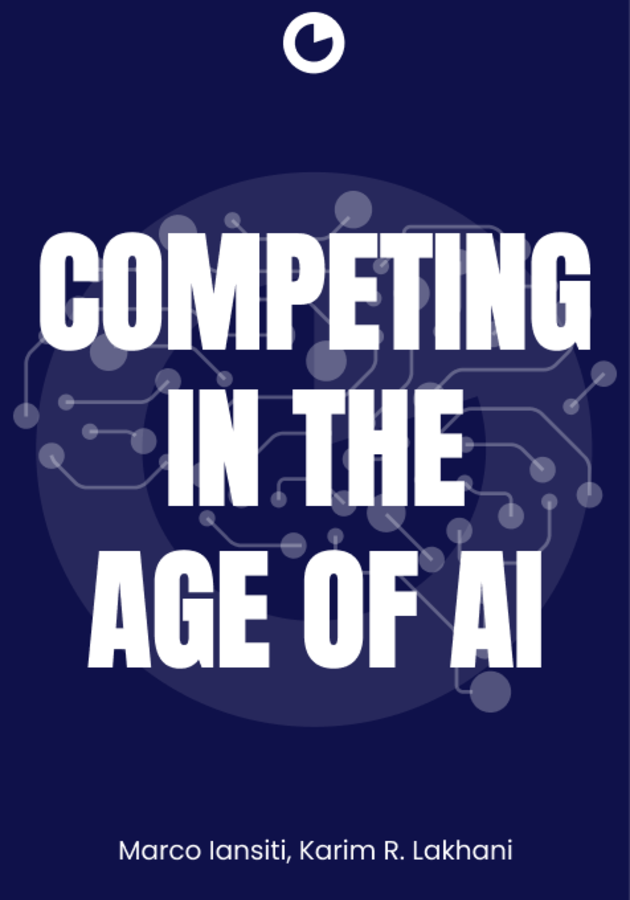AI-centric organizations are changing how they do business, thanks to new technologies like data analytics and artificial intelligence. The coronavirus crisis forced companies like Massachusetts General Hospital, Verizon, and IKEA to adapt quickly. In their book, "Competing in the Age of AI," Marco Iansiti and Karim R. Lakhani explain how these technologies help companies break free from old limitations and grow faster.
They show how AI-driven processes are more scalable, allowing companies to expand their reach and learn more efficiently. This means companies can predict trends with greater accuracy. The book offers a framework for rethinking business models and discusses how digital ones challenge traditional companies.
Using examples from innovative companies like Airbnb and Amazon, the authors illustrate how AI reshapes industries. They argue that embracing AI removes old barriers to growth and fundamentally changes how businesses operate. In an AI-driven firm, software and algorithms play a crucial role in delivering value and transforming the way companies work.
The AI era completely redefining the business scene
While they mention AI in the title, which may grab attention, this book extends far beyond that topic. According to the authors, both professors at Harvard Business School are well-versed in digital company operations, and a new breed of firm is emerging, shaping what they dub a fresh economic era. These firms include giants like Google, Facebook, Amazon, Uber, and Alibaba, driving an economy rooted in data, networks, and AI.
The authors acknowledge other significant technological advancements like microprocessors and the internet, drawing parallels with the Industrial Revolution. However, they argue convincingly for the unprecedented nature of this new era, supported by detailed case studies and theoretical analysis. The book explores how firms like Ant Financial, Ocado, and Peloton have revolutionized operations by minimizing human involvement and relying instead on AI-powered digital models. It delves into the strategic implications of constructing organizations around code rather than human labor, emphasizing the shift in competitive advantage from production technologies to data accumulation.
They discuss the strategic dynamics between digital and traditional firms, showcasing recent case studies and industry shifts. The authors also delve into this new age's ethical, political, and regulatory implications, concluding with insights on leadership in this transformative landscape. While the authors make a compelling argument for the emergence of this new era, they caution against idealizing certain companies, pointing out pitfalls such as Peloton's product recalls and Alibaba's regulatory issues.
Embracing AI can create big chances for growth and success in many areas
It was only a matter of time before AI technology would take such a big swing that it would signify a real revolution in all spheres of human life. Whether this technology will be used to create a better and more prosperous future, or perhaps in some way even lead to such a catastrophic outcome as the collapse of humanity, remains to be seen.
Let's recall a moment when the world was shocked in 2016 when, with the help of a computer engineering program, a work by Rembrandt was recreated that everyone would have thought was another undiscovered piece of the legendary master. This was just a prelude to what awaits us in the future and what the business and creative world will face. It is no secret that digital technologies are reshaping the business world, breaking down traditional barriers, and setting a new canvas where there is an expansion of thoughts, ideas, and their realization.
The reality is that to succeed in any sphere, including business, it is essential to follow the trends. And as much as it sometimes doesn't align with our credibility and character, it is the only truth. On the positive side, implementing these technologies is truly revolutionary in a beneficial and functional sense. Tasks that used to require hard work and a great deal of physical and mental effort are now easily performed in a much more detailed and concise manner. Learning, which was once a slow, human-driven process of trial and error, is now accelerated and refined with the help of algorithms, machine processing, and learning that perfect each task.
Success is dependent on establishing and keeping beneficial connections, not simply internal talents
The digital world is challenging, we have to admit it, and succeeding in business is about more than just what you can do internally. It's also about understanding the bigger picture of how your business connects with others. Since the dawn of time, connection with others has been the condition for survival, which is also one of the main rules in business.
Imagine your company is a dot in this vast web. Each dot symbolizes a stakeholder, including suppliers, customers, partners, and even competitors. The authors here advise that to thrive, you need to understand how all of these dots connect and influence one another. This process is called strategic network analysis. It's like diving deep into the spider web to see where all the strands lead. They suggest that using advanced tools and techniques, you can determine which connections are the strongest and where the most important information, goods, and services flow.
Once you have this data, you'll be in a better position to spot opportunities for collaboration. Maybe you'll find a supplier who can also be a partner or discover a new market through a connection with a competitor. They state that the key is using this information wisely to strengthen your business and succeed in the digital age.
A shift in perspective is very much needed
The authors encourage a shift in perspective when considering AI's role in business strategy. Instead of focusing solely on what AI can do for a company, they suggest reflecting on what the company can do to leverage AI effectively. This approach emphasizes the importance of understanding how AI-centric organizations operate and what non-AI-centric organizations can learn from them. The authors highlight several advantages of AI processes that companies can leverage, including scalability, increased business scope, the ability to transcend industry boundaries, opportunities for learning, and the ability to make accurate predictions.
The authors argue that traditional operating models, rooted in mass production paradigms, may not effectively leverage modern AI technologies. They propose restructuring firms by implementing agile teams and customer-focused processes and empowering employees to utilize AI tools effectively. This restructuring aims to better understand consumer needs, leading to improved products and a positive customer experience cycle.
To fully realize the transformative power of digital technology, business executives must actively map their current processes against the potential for digital augmentation. What should you do? The authors advise that you simply educate yourself about the implementation of these systems as best as you can and begin a comprehensive audit of your operational workflow to pinpoint areas where automation and AI integration could bring significant efficiency gains.
For example, if you manage supply chains, implementing machine learning models can predict spikes in demand, avoid bottlenecks, and optimize inventory with unprecedented precision. But you have to remember that the transition doesn't just happen in terms of upgrading the technological tools; first of all, you have to familiarize yourself with them and change the way you think and see them. Thinking ahead to the future is an advantage. As you gaze into the horizon of business opportunities, remember that limitations we once took for granted can now be easily overcome. And in doing so, you'll not only navigate this ever-evolving landscape, you'll help shape its future.
Companies need to think about how they fit into many industries, not just one
By doing exhaustive research on how companies use data analytics and artificial intelligence to improve their business, the authors explain that many companies are using these technologies well and seeing better results. They looked at various industries, like manufacturing, finance, and retail, with companies of different sizes. Their research showed that companies with much AI experience are doing well in different parts of their business by using data to make faster decisions, improve how they serve customers, improve their operations, and even predict when equipment might break down.
The authors discuss how companies move from having data in different parts of their organization to having a fully integrated system where AI is used everywhere. But they also say it's not easy for companies to change their structure to make this happen. They use Fidelity Investments as an example of a company that made significant changes to become more focused on AI. Fidelity spent a lot of money to improve its use of data and AI. They hired really good people and made it a priority to be flexible and come up with new ideas. They put all their data in one place, started managing products with AI in mind, and got better at quickly making new things.
The authors talk about how businesses are changing in today's digital world. They say it's not enough anymore to just focus on one industry. Companies must understand how they connect with other sectors and how data moves between them. They say that knowing this helps companies stay competitive. Instead of just looking at one industry, they say it's essential to look at how a company fits into a more extensive network of sectors and how data moves through it. They introduce the idea of network effects, which means that the more people use something, the more valuable it becomes.
They talk about two kinds: direct, where users value each other being there, and indirect, where one group of users loves another group being there. They also talk about learning effects, which means that the more data moves through a network, the better it gets. They say these effects can help a company stand out, especially when working together. They give examples like Google's search getting better with more searches and how data can help improve healthcare.
Businesses need to understand and leverage concepts to remain competitive
The authors discuss two main concepts: network bridging and strategic network analysis, and how they are crucial for businesses to understand and leverage in today's digital age. Network bridging involves connecting separate economic networks to improve competitiveness and value creation. Examples like Google and Alibaba show how companies bridge their core businesses with other networks, like advertisers or financial services, to create synergies and capture more value. Strategic network analysis is about evaluating a business's connections to various networks to understand its potential for value creation and capture.
Using Uber as an example, the authors analyze its connections to riders, drivers, and other stakeholders, considering factors like network effects and bridging opportunities. The authors provide a structured approach to strategic network analysis, including mapping networks, evaluating value creation, and identifying bridging opportunities. They also discuss "strategic collisions" between digital and traditional firms, using examples from industries like travel and mobile phones to illustrate how digital firms disrupt traditional markets.
Lastly, they highlight the importance of adapting to digital transformations by adopting data-centric operating models and leveraging scale, scope, and learning advantages to remain competitive in rapidly evolving markets across various industries like retail, entertainment, computing, and automotive.
The ethical challenges of the digital era and their impact on businesses and society as a whole
The authors discuss the rapid changes happening in our economy due to the rise of digital operating models, powered by software, data, and AI. These new models are breaking traditional constraints and creating new business opportunities that span across industries. They mention "hub firms" like Apple, Google, Amazon, and others, which are central to this transformation, connecting various industries and capturing a significant share of value. These hub firms, through their platforms and operating models, control essential connections in key networks, making it necessary for other businesses to engage with them to reach consumers.
The authors highlight the increasing concentration of value and information in these digital networks, which brings both opportunities and challenges. However, alongside the benefits, there are ethical considerations arising from these digital transformations. For instance, they mention how algorithms used by platforms like Amazon, Facebook, and Google can unintentionally amplify harmful content or biases, as seen in the spread of anti-vaccination propaganda. Moreover, the authors address algorithmic bias, emphasizing that flawed data inputs or assumptions in algorithms can lead to inaccurate AI-driven decisions.
They provide examples of bias in platforms like Airbnb and financial services, highlighting the potential negative impact of digital operating models. Overall, the main point in these chapters is about the importance of understanding and addressing these ethical challenges in the digital era, as they affect not only businesses but also society as a whole. They call for awareness and action from managers, leaders, and citizens to ensure the responsible use of digital technologies.
Addressing fairness and equity in the digital economy is paramount for a more equitable landscape
Finally, the authors discuss various types of biases and cybersecurity issues in digital systems. This bias happens when the data used for analysis doesn't accurately represent the entire population. For example, Amazon's HR system in 2018 devalued female job candidates because it was trained mostly on resumes of male engineers. Similar issues occur in finance, insurance, and law enforcement. Biases like this can affect critical decisions, such as loan approvals or job hires. This bias occurs during the process of labeling or tagging data, often done by crowdworkers.
For instance, a study found that images labeled by crowdsourced workers showed biases; for example, a picture of a woman and a man might be labeled as a conversation between a woman and her boss. This labeling bias extends to other areas, like gender roles and racial stereotypes. Cyberattacks are becoming more frequent and sophisticated. Companies face challenges in protecting sensitive data from breaches. For example, Equifax experienced a massive breach in 2017, exposing personal data of millions of consumers. Such breaches highlight the importance of investing in cybersecurity measures, upgrading IT systems, and ensuring timely responses to threats.
Next, they talk about the concept of "hijacking" in digital systems, where malicious actors exploit digital platforms for harmful purposes. They provide examples, such as the Christchurch mosque shooting livestream that was shared on Facebook, resulting in the spread of violent content despite efforts to remove it. They also mention Russian-sponsored efforts to influence political campaigns through social media manipulation.
Furthermore, the main highlight here includes the challenges faced by platform companies like Facebook and Google in controlling their ecosystems to prevent misuse. They discuss the case of Cambridge Analytica, which harvested Facebook user data for political purposes, illustrating the complexities of platform control and data privacy. Moreover, the authors delve into ethical considerations surrounding platform control, including questions about free speech, privacy, and censorship. They emphasize the need for stakeholders to address these challenges as digital operating models become increasingly influential in society.
Lastly, the authors raise concerns about fairness and equity in the digital economy, particularly regarding the concentration of power among firms and the distribution of value and decision rights. They highlight the importance of addressing these issues to ensure a more equitable digital landscape.
Final notes
Competing in the Age of AI discusses how AI reshapes businesses and gives valuable guidance on adapting to this evolving landscape. The book is written in simple language, avoiding complex technical terms and making it accessible to managers leading the digital transformation.
It emphasizes the importance of data, analytics, and AI in driving business success, allowing companies to overcome previous limitations and achieve superior performance. Using real-life examples from companies like Amazon and Google, the authors illustrate opportunities and risks, offering a roadmap for navigating the challenges both digital and traditional firms face.
12min tip
"The Power of Now" takes readers on a journey to discover how to connect with the indestructible essence of our own being. Tolle guides readers on how to surpass the obstacles and barriers within themselves.





























